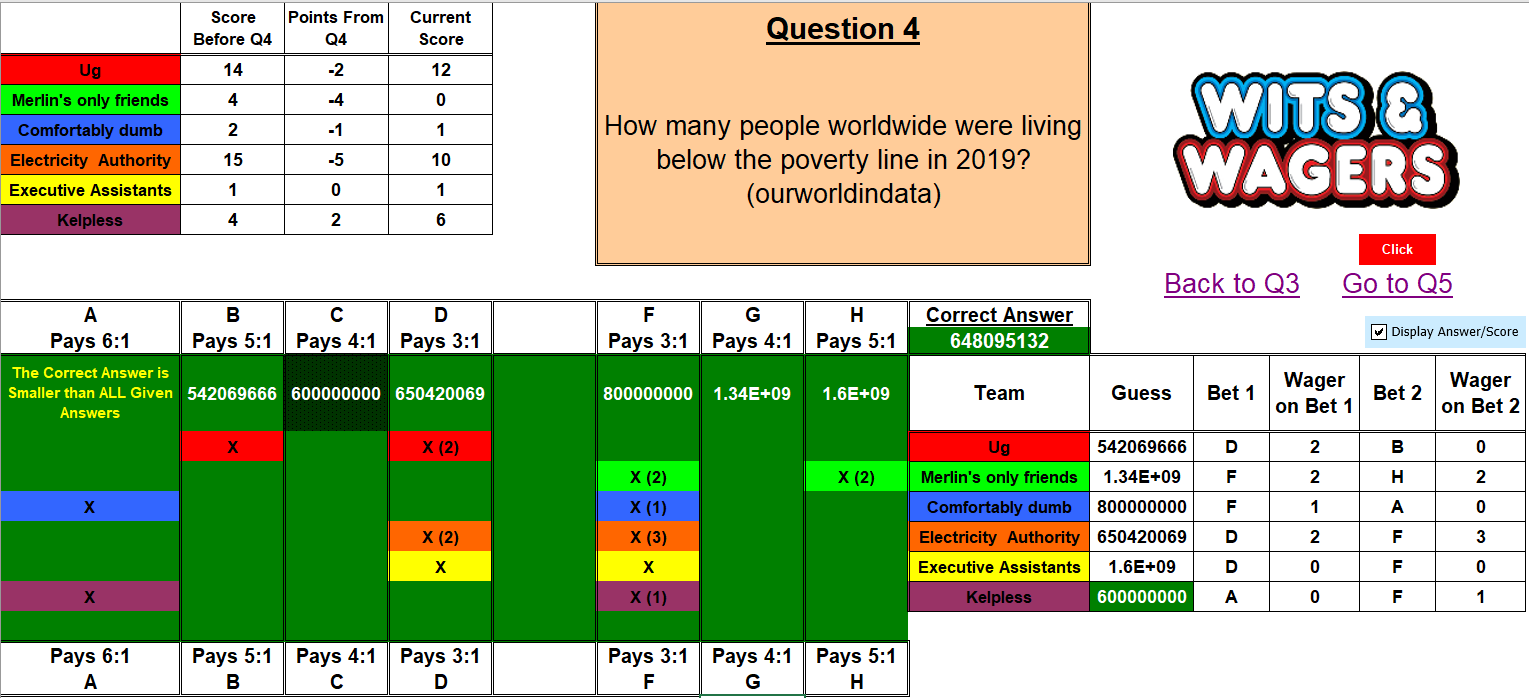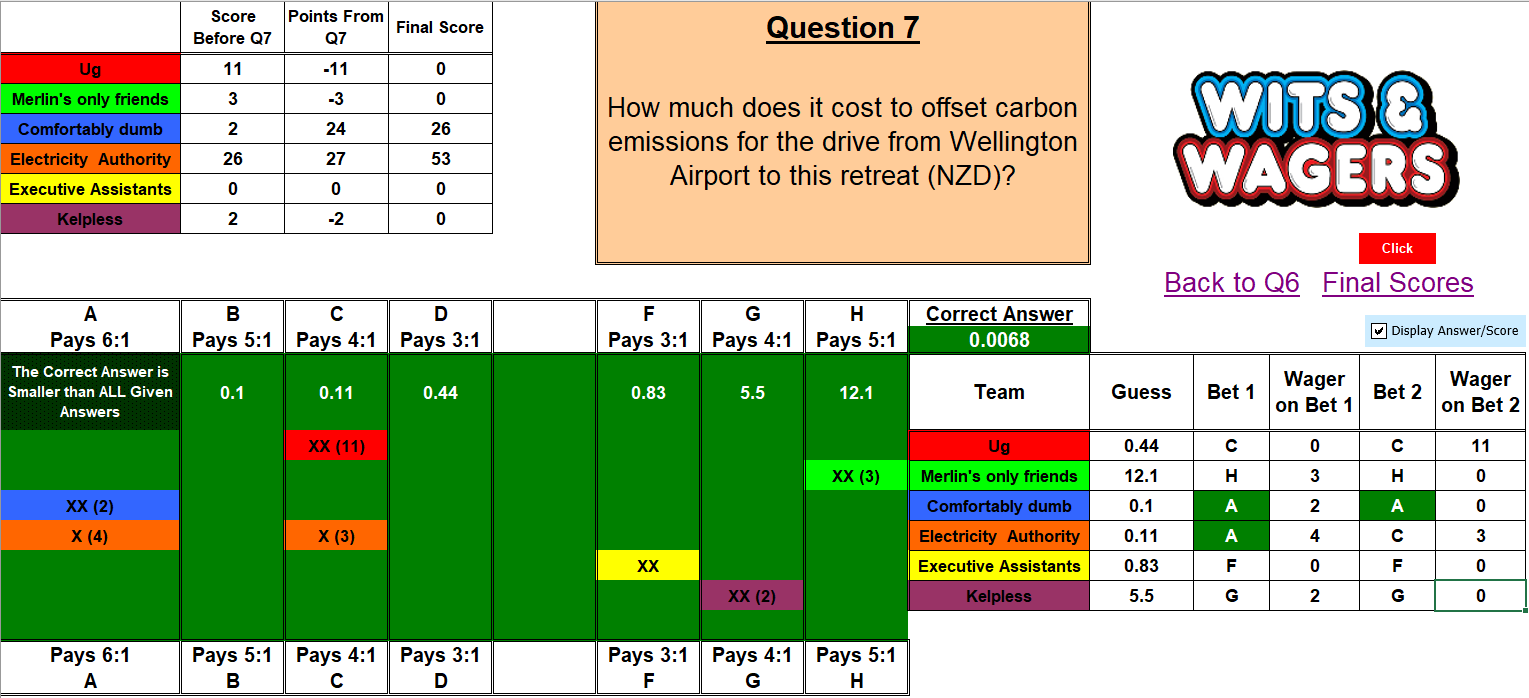I'd like to share my experience in both running and playing the game Wits & Wagers at EA retreats in New Zealand. We have played the game at every yearly retreat for the past five years, with me writing questions and hosting for three of them, and playing as part of a team in the other two. They have consistently gone down well, with several people noting them as a highlight of the retreat. I’ll lay out why I believe the game is relevant in an EA context, the mechanics of playing the game in a large group, how to write good custom EA questions, and some reflections on playing the game at recent retreats.
Relevance
Wits & Wagers is a trivia-based game that involves both answering questions, and betting on the other player's answers, with points awarded for being correct in either or both. In an EA context, the game offers an opportunity to practise creating quick Fermi estimates and to work on judgement calibration. By writing custom EA relevant questions it also allows participants to flex some of their knowledge and others to connect with useful EA metrics.
Mechanics
Although the game was originally developed as a board game, with each participant playing individually, there is a version developed as an Excel spreadsheet to allow large groups to play. It functions exactly the same way as the board version but is best displayed on a large screen so that all teams can see it.
It allows up to seven teams, and I would suggest aiming for close to this number, with teams as small as two people if necessary. Each question consists of two stages, estimating the answer, and then betting on answers. With EA-type mindset teams and good questions each of these stages can take substantially longer than the one minute suggested in the rules. I’d suggest allowing closer to 5 minutes for robust team discussion on each of these steps. This means that a seven question game typically takes around 90 minutes to complete, once you account for gathering answers and stepping between questions.
The game rules suggest that all answers and bets should be written down and handed in before being made public, however this can be difficult in a large venue and I find it easier to just ask around the teams and type them into the spreadsheet live. Although I’d recommend still asking the teams to write down and commit to their answer in advance, as there is some incentive to modify both answers and bets once you know how other teams are answering/betting. Another useful additional step to make this a fair process is to start with a different team each time you go around the room to gather answers.
Writing good questions
I’d recommend writing custom EA-related questions for the game. This makes it more relevant and engaging, but does take some effort to prepare. The basic requirements for questions that make the game work are:
- The answers need to be numeric.
- The answers need to be on a continuous scale.
For good questions I think the following also apply:
- The answers shouldn’t be things that anyone present will explicitly know.
- The answers should be broadly estimable based on general knowledge of the topic (i.e. Fermi estimates).
- The answers should be at a level of precision such that multiple teams are unlikely to estimate the same answer (the spreadsheet will cope with this, but it makes the betting part slightly less interesting).
- The units the answer is expressed in should be noted in the question (although not necessarily at the correct order of magnitude/SI-prefix if you wish to anchor answers in the wrong direction).
Additionally, in an EA context, I try to apply the following:
- The questions should be spread across different aspects of EA or cause areas.
- The questions, or verbal notes read out to accompany the question, should mention the source (e.g. website, research org, etc) and context (e.g. year) of the answer.
- More complex questions should come later in the game, so that beginners are able to get a feel for it.
Questions used at the most recent retreat included:
- What percentage of philosophers "Accept or lean towards" consequentialism? (2020 PhilPapers Survey)
- How many months is it since the Effective Altruism NZ Charitable Trust was first registered with charities services?
- How many GB of text training data was provided to ChatGPT?
- How many people worldwide were living below the poverty line in 2019? (ourworldindata)
- How much does it cost to offset carbon emissions for the drive from Wellington Airport to this retreat (NZD)? (Average NZ passenger vehicle 2019, Founders Pledge “realistic” cost-effectiveness estimates for Clean Air Task Force 2020)
An example previous set of EA questions are also online here.
Reflections
I’d strongly recommend the game as an EA retreat evening activity that most people will be happy to engage with, allows the practice of a useful EA skillset, encourages teamwork, promotes knowledge of EA relevant data, and is generally good fun to play. Feedback from our retreats has been overwhelmingly positive.
Generally the wisdom of crowds shows in the answers and the correct answer sits roughly in the middle of the estimates. This is reflected in the odds the game provides for bets on each answer, and winning strategies typically defer to the crowd average answers. Exceptions to this are where a team is particularly knowledgeable about the subject area and wishes to back themselves (hence the benefit in spreading the question topics), or where there is a team in the room that is known (to everyone) to contain experts on the topic; in these cases betting on a specific answer (even at high stakes) can be beneficial.

Teams are able to wager their points received in prior questions on each new question, and we’ve found relatively conservative betting tends to occur in the first few rounds in order to accumulate points. There is, however, the possibility of teams adopting an ‘all or nothing’ approach to the last couple of questions, by waging all of their points, sometimes on the highest stakes (i.e. least likely) answers. This can be a fun approach, but is probably not a practice that should be generalised outside the game environment. A possible motivation against this behaviour would be to award prizes (e.g. servings of dessert) in ratio to the final number of points achieved (although I've not yet tested this in practice).

An alternative or complementary activity that has also worked well at New Zealand retreats has been a Forecasting tournament.




I love Wits & Wagers! You might be interested in Wits & Calibration, a variant I made during the pandemic in which players forecast the probability that each numeric range is 'correct' (closest to the true answer without being greater than it) rather than bet on the range that is most probable (as in the Party Edition) or highest EV given payout-ratios (regular Wits & Wagers). The spreadsheet I made auto-calculates all scores, so players need only enter their forecasts and check a box next to the correct answer.
I created the variant because I think it makes the game higher skill. For example, rather than just bet on a range that you know is the most likely to be correct, you can be rewarded for knowing whether it's 60% likely or 80% likely to be correct, unlike in classic Wits & Wagers where everyone would bet on the range simply by knowing it's >50% likely to be correct and get an equal reward.
I only play-tested it once (in-person with three people with one laptop plus one phone editing the spreadsheet) and the most annoying aspect of my implementation of it was having to record one's forecasts in a spreadsheet from a phone. If everyone had a laptop or their own device it'd be easier. But I made the spreadsheet to handle games (or teams?) of up to 8 people, so I think it could work well for that.